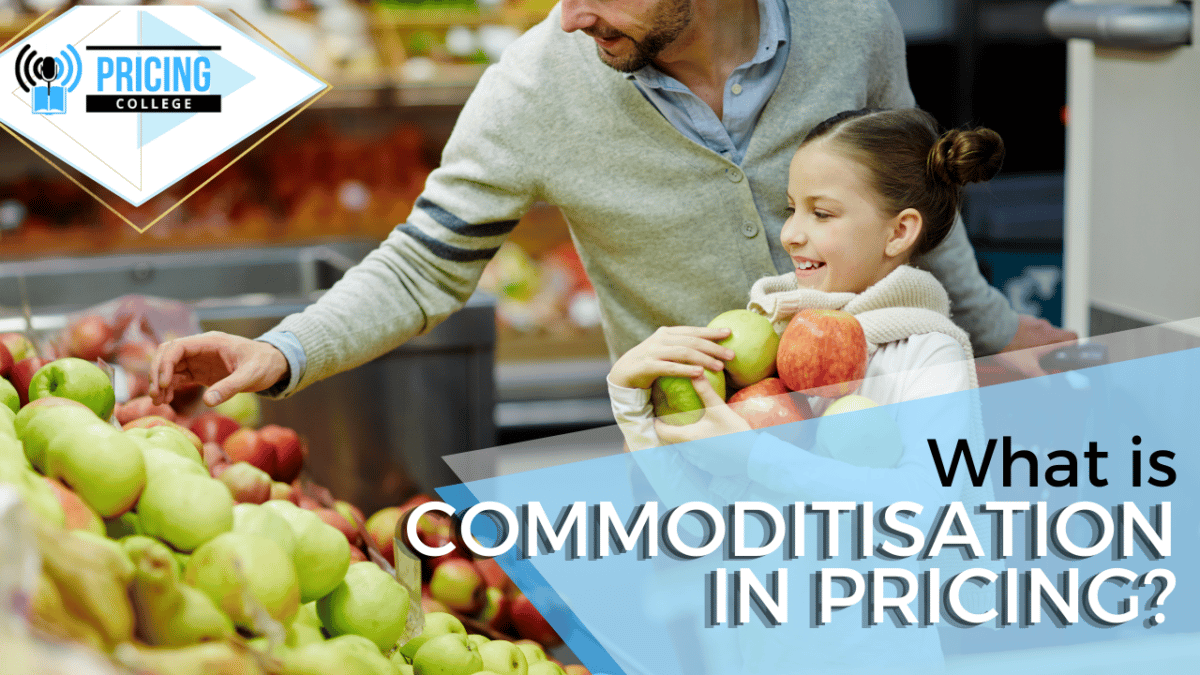
What Is Commoditisation in Pricing? 🍎 Podcast Ep. 9
In this episode of Pricing College’s podcast – Aidan and Joanna discuss commoditisation of a product or service in pricing – and why it can really impact your profitability over time.
Listen on Apple Podcasts Listen on Spotify Listen on Google Podcasts Listen on Stitcher Listen on Amazon Music
TIME-STAMPED SHOW NOTES: COMMODITISATION IN PRICING
[01:05] Does the finance team undermine your value efforts?
[01:20] If you compete on low price – is your product just the same as all others?
[01:45] Aidan gives examples such as shares on stock market, or raw materials.
[02:15] Joanna talks about the commodity mindset.
[02:35] Some customers buy on a price-only basis. Commoditisation mindset in pricing occurs on both buyer and seller’s side.
[03:05] B2B tenders often push you down to commoditisation in pricing.
[03:30] Aidan compares apples with apples!
[04:15] Value drivers such as delivery time are often not even discussed.
[05:10] What is the risk in buying from a certain supplier vs. another?
[05:50] Would you pay more for a Rolex from a shop or a street corner?
[06:30] We pay more to avoid risk when making a buying decision.
The Antithesis of Value-based Pricing: Commoditisation in Pricing Explained
In today’s episode, we want to take an almost counterintuitive approach. We’ve talked about “what is value-based pricing?” in the past. In this instance, we’re going to ask “what is the polar opposite of that?” What is the commoditisation of a product or service?
We sort of touched on that with the commodity mindset. But it’d be an interesting conversation just to unpack what that means in terms of how different business leaders think.
From my personal experience, I’ve worked in companies where the marketing people could talk about the value all day long. But sooner or later, someone in the finance department would argue and say “no, no we only sell at a low price, the customer only buys at a low price.”
I suppose they’re the polar opposite of the same polar opposites of the spectrum. Especially when we look at value pricing and what we’re trying to sell. If you are competing at a purely low price, you’re making an assumption that the product or service you’re selling is literally identical to that of your competitors, new entrants, or anybody else in the market.
This could be true in the instance of buying a share in the stock market. See, where the share you’re buying would be a share in Qantas or any company you want to think of. The stockbrokers may give you different services or experiences. But you’re buying on the market and the price you pay will be the market-clearing price at that point in time.
You could also think of what are the very commoditised products. Now, we think of raw materials things like coal, timber, and oil. Those sort of things. As long as they’re coming from the same area, the material is chemically the same as another one. And it’s pretty close to being commoditised.
People think in that commoditised way of thinking about it as if they are trading in the stock exchange. They’re thinking about things as a sum of its parts. There’s a very component-based, unit-based sort of price thinking and logic.
Equally, I would say we can’t dismiss that because there are some customers that buy in the very same way. And we call those price-sensitive customers. But on the other hand, there are customers that don’t see an item based on what it’s made of. They think about the value it can give them and the problem it solves at a particular point in time. I think they’re both perspectives can be seen on the buyer side and the seller side.
I think another area that nearly everyone in the pricing profession, at least in the B2B environment has looked at, is doing tenders. This is where you’re dealing with procurement professionals who are almost trying to shout at you that your product and service is commoditised. And it’s purely a red card exercise that they want the lowest price and that they’re not considering the additional value.
That’s something many of us have gone up against. In fact, it’s trying to explain, we’ll give you the example. If you’re buying two apples, people also had apples and apples. Now, you’re comparing two apples. But if your two apples were on the table you want to ask:
How fresh are both apples?
Were they grown organically?
Were they grown with modern chemicals?
Will that apple will be delivered to me?
Or will I have to go and collect that Apple?
Can I pay that Apple with cash?
Do I have to pay for it with credit terms?
There’s an infinite number of things that could be slightly different about that apple. That’s something that is seemingly commoditised by the time you eat it, consume it, and then enjoy it. It’s a completely different experience.
It’s quite strange if you’ve talked about all those things that can be involved in just buying an apple. But often, they’re sold based on what they look like. The features and benefits and all of those other risk drivers are what I’d called. What you are really saying is delivery time, and failure to supply, or things like that. I really never discussed, but potentially that’s why the procurement does gravitate to unit pricing discussions.
It’s interesting that there’s a lot to go about on apples. I believe in Japan, there is a very common gift that people give. It is a very aesthetically pleasing fruit. But the fruits are not designed to be eaten, but it’s designed to look at. It will come in a nice box and presentation gift set which is a completely different value driver than somebody eating the apple. So yeah it asks:
What is the product really for?
Are the products and services commoditised items?
Or is it the paraphernalia that goes with it?
I suppose that to summarise, it’s the value in use and the value-at-risk principles. And you need to appeal aesthetics show of value at use. Some people buy purely on that. But other people buy the value at risk. In fact, they want to ensure that a certain product is going to come to them without any delay. There’s not going to be any product failure and they want you to describe to them how you’re going to do that. Now, that is the discussion that does drive additional price premiums, especially with procurement.
I think there’s often a huge amount of risk in the purchase decisions. Now, what you want to do as a smart buyer is reduce any potential risk.
You go to buy like a Rolex watch. Then, you can either go to a reputable jewellery store. You buy the watch you see the exact type of it. And you’ll get a guarantee or a warranty that if it breaks you can bring it back to get repaired. It will also likely come in a beautiful gift box, all wrapped up and it’d be presented to whoever is going to.
The alternative is you buy it from a dodgy guy on the street corner. He has assured you it’s fine and you probably get it at a much-reduced price. But are you really buying the same item? There’s a very high chance it is the same item as a basic watch. But the paraphernalia around that you’re purchasing reduces your risk that makes you happy – they’re trouble chasers.
Largely, we buy because we want to avoid risk as well as the actual thing that we’re buying. A good pricer will think about what a product is when they’re setting prices. They will also think about the risk that the customers are avoiding by buying that product from that business. And that really is one of the secrets of really great pricing. Setting pricing on value, unpacking value in terms of value-at-use, and some value at risk.

LINKS MENTIONED IN TODAY’S EPISODE: COMMODITISATION IN PRICING
For a comprehensive view on building a great pricing team to prevent loss in revenue,
Download a complimentary whitepaper on How to Build Hiring Capability To Get The Best Pricing Team
Related Posts
Leave a Reply Cancel reply
Categories
- marketing strategy (26)
- Organisational Design (14)
- Podcast (114)
- Pricing Capability (87)
- Pricing Career Advice (10)
- Pricing Recruitment (19)
- Pricing Strategy (287)
- Pricing Team Skills (13)
- Pricing Teams & Culture (24)
- Pricing Transformation (47)
- Revenue Model (25)
- Sales Effectiveness (27)
- Talent Management (7)
- Technical Pricing Skills (35)





